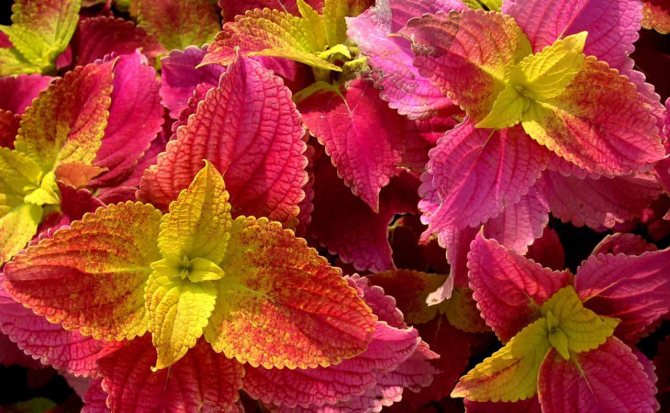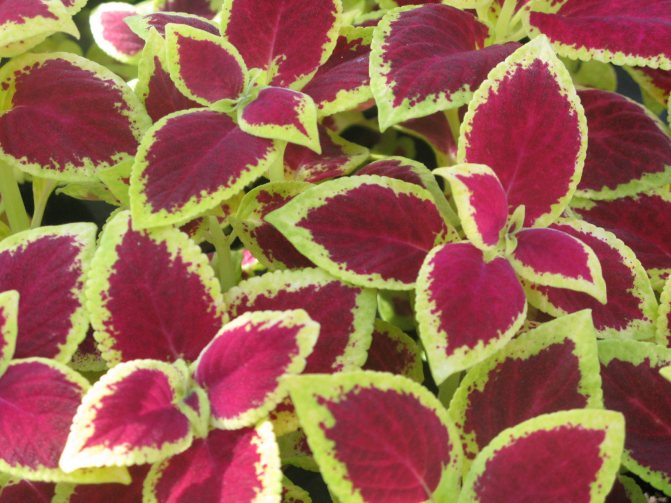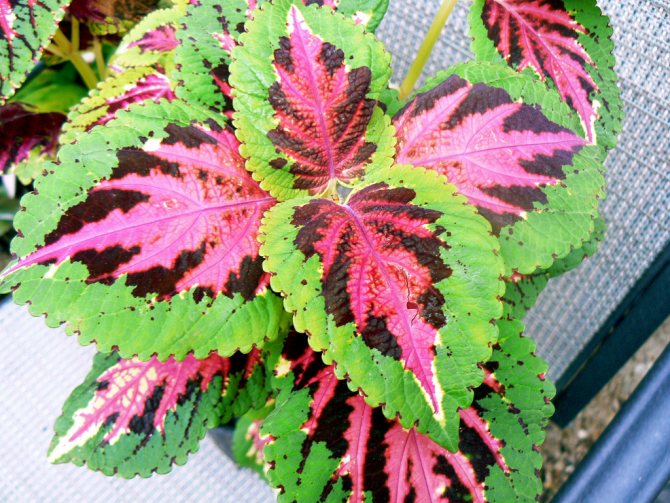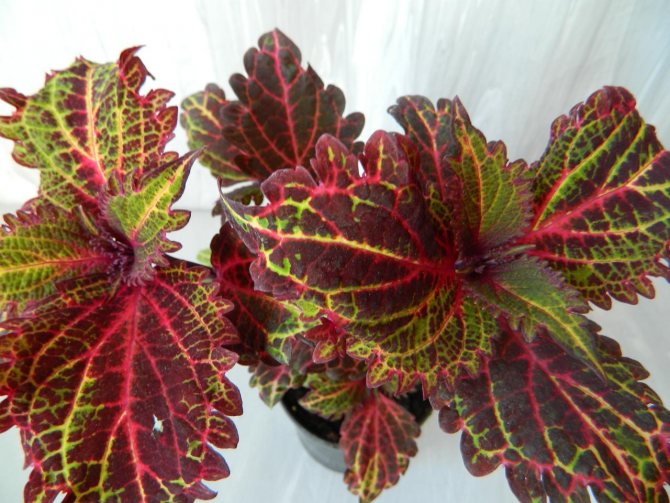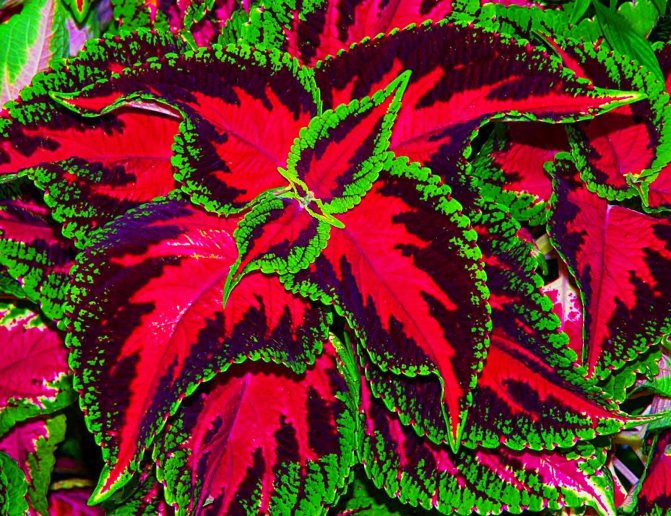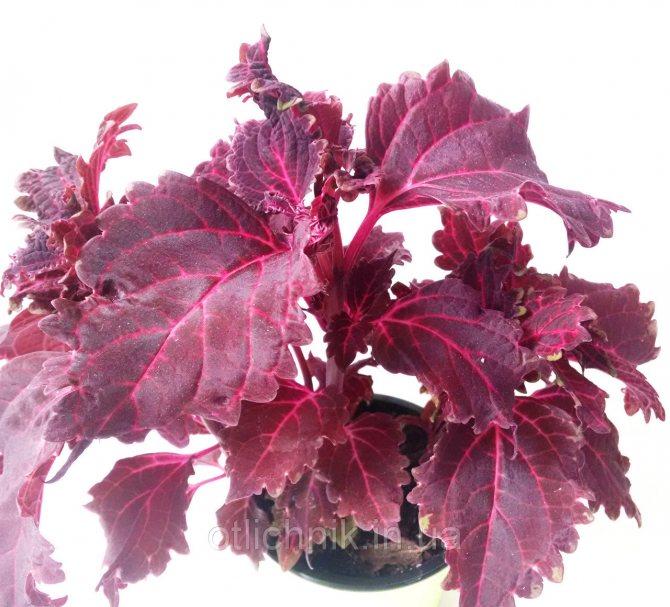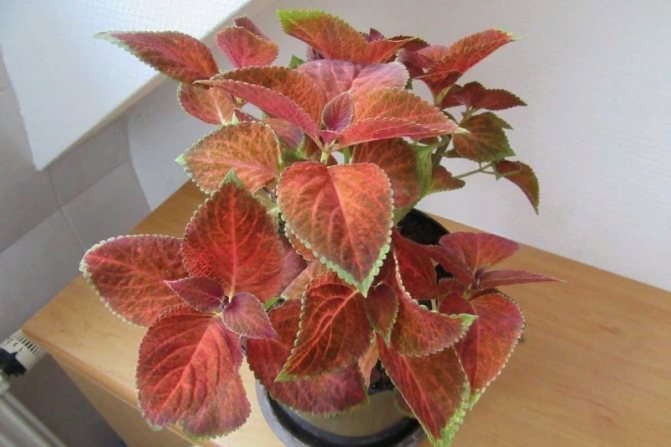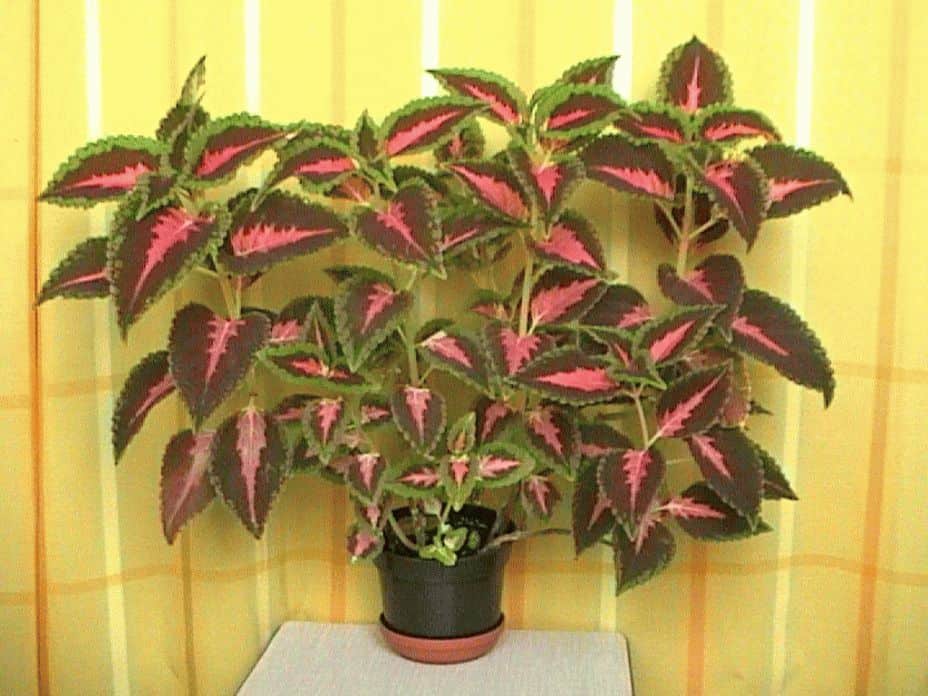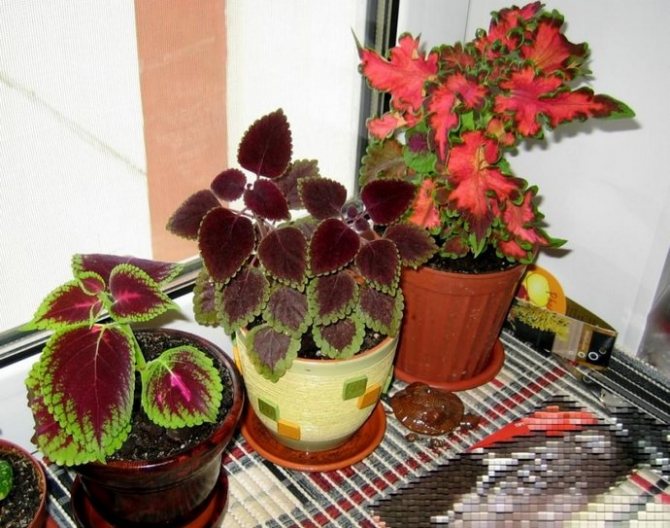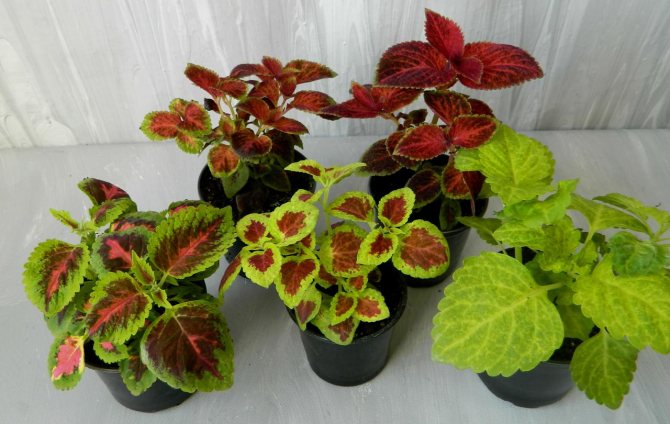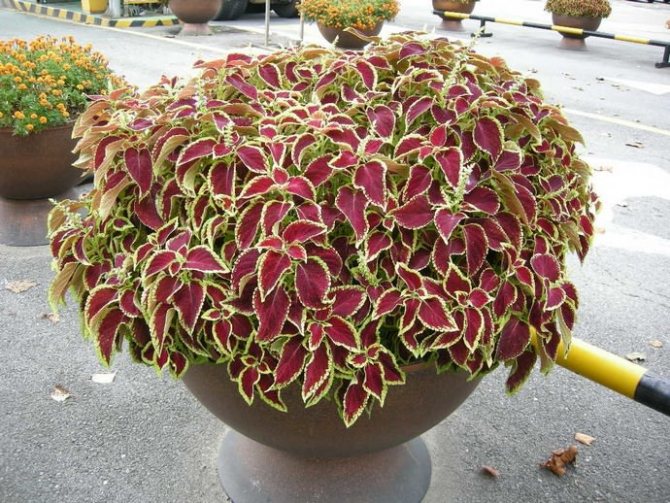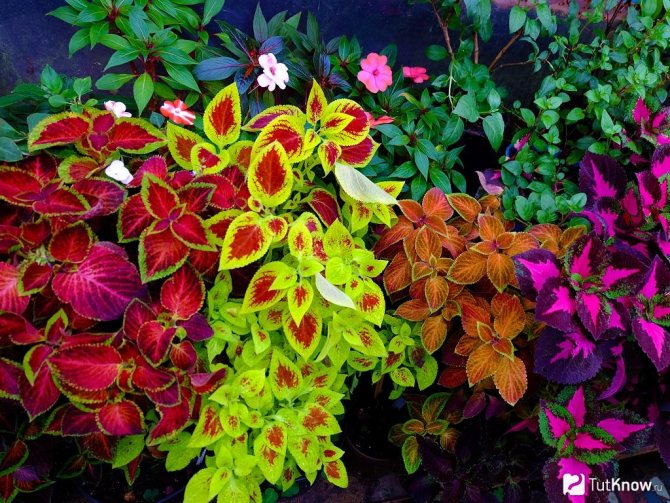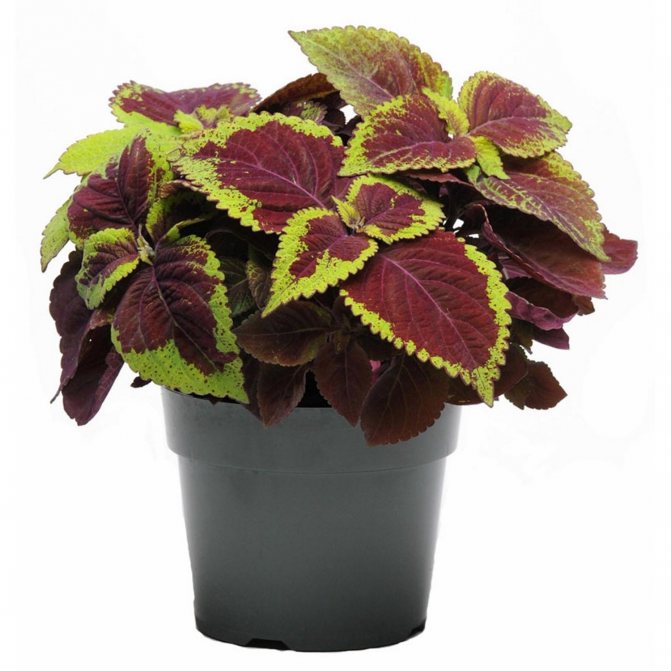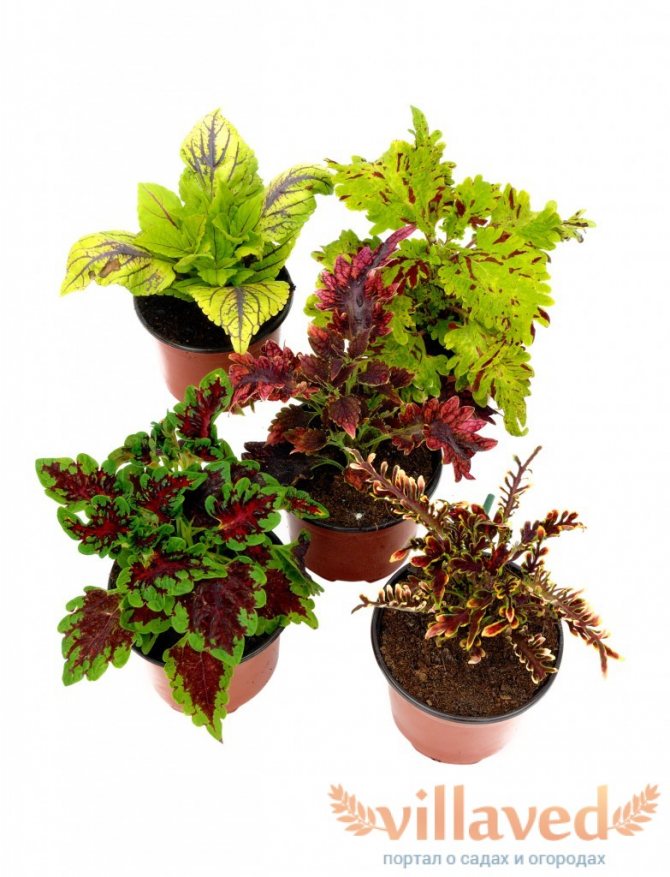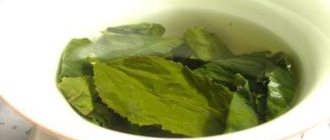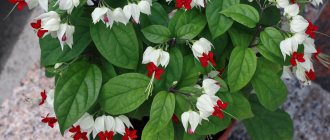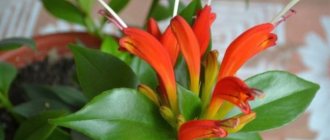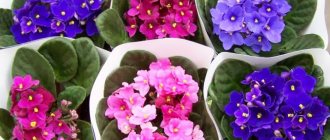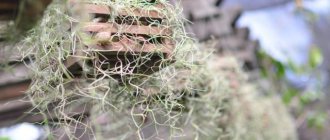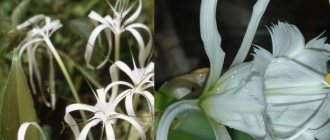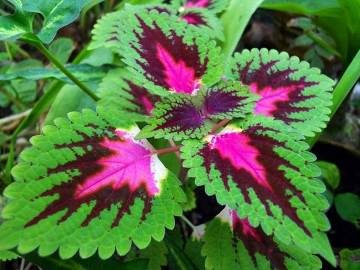
Coleus is a very unusual mysterious house plant. The bright red or brick leaves of the flower, framed by a green border, give it a unique appearance, which is why the plant is so fond of flower growers. For the first time, Coleus was discovered in warm and humid regions of Asia, and now the oriental visitor has gained popularity all over the world.
Many legends are formed around the flower, and it will also take superstitions. For example, it is believed that coleus, or in the people - nettles, very powerfully cleanses the energy of the house, removing all negativity. And according to some beliefs, Coleus is able to inform the owners that someone close to them is seriously ill.
In general, esotericists have a rather positive attitude to the flower - this "Asian" perfectly "cleans" the aura of the room and households, and also gives the interior a pretty look. So is it worth keeping a decorative coleus on your windowsill at home or is it worth being wary of this magical flower - what will signs and superstitions tell about it.
Good omens about Coleus
- The appearance of a tropical exotic in the room will certainly ennoble the energy space of the room. Households near the flower experience a surge of strength and positive emotions, get rid of worries and ailments, begin to think better and more often make the right decisions in difficult situations.
- Coleus is also a welcome guest for office space. After all, its positive impact attracts business luck, helps to make a career, and maintains trusting and productive relationships between colleagues.
- The flowering of any plant with magical properties is of particular importance, exacerbating its positive or negative qualities.
Photo gallery
Signs about the flower coleus or nettle
If the nettle has picked up buds at the right time (spring or summer), then you should prepare for positive changes in the life of the family or a career takeoff. However, the flowers that appeared in the winter should be alarming, since financial problems are highly likely to predict.
If the coleus bloomed
A lot of signs about Coleus are associated with the period of its flowering. This usually happens in the spring or summer. If indoor nettles are blooming on schedule, it is good luck.
The inflorescences that have blossomed at the wrong time are popularly considered an omen of imminent financial problems.
An indoor flower is capable of budding in winter, which is uncharacteristic for it. In blooming nettles at the wrong time, they see a harbinger of trouble in the coming period.
Bad beliefs about nettles
In addition to numerous good signs about Coleus, there are many negative superstitions that prohibit the cultivation of this guest from the tropics in the house.
- One of the most popular interpretations of the content of a variegated flower in a house predicts that its owner will soon be "broke." Most likely, such a belief appeared in those days when the presence of ordinary nettles on the windowsill was a sign of low income. After all, wealthy citizens could afford more spectacular exotics like croton, dracaena or yucca.
- Superstitious people classify Coleus as numerous. Often, the divorce or widowhood of a woman, the inability of a girl to find a loved one and become a married lady is explained by the presence of a tropical flower with bright leaves in the house.
- So the saturated purple shades in the color of the leaf plates that attract many flower growers have served the nettle a bad service. Thanks to them, the plant is credited with the ability to attract fires to the house. Therefore, if you are afraid of losing your property in a fire, never grow this exotic on the windowsill.
The best neighbors for a plant outdoors
To grow Coleus, you need to choose well-protected, light or slightly shaded areas, so neighboring plants should have the same level of endurance of direct sunlight. Variegated coleus successfully coexist with ampelous petunia, pelargonium and fuchsia. The addition of coleus with hosts and daylilies can be a good one. It should be borne in mind that the peak of the decorativeness of plants falls on the fifth month after the sowing work. Among other things, a feature of small-leaved varieties is faster growth and optimal soil cover.
What does a sick Coleus warn about?
Nettle owners should pay special attention to the condition of the plant and proper care for it.
- If, despite proper care, your specimen suddenly begins to wither, dry and shed leaves, you should pay attention to the atmosphere in the house. Most likely, due to constant conflicts or strong feelings of household members, so much negativity has accumulated in space that the plant simply cannot cope with its neutralization. It is necessary to urgently change something in the relationship and look at life with greater optimism.
- It happens that careless owners do not seek to pay attention to the flower, forgetting not only to loosen the soil and feed, but even water the plant on time. Such neglect can turn vengeful Coleus against you, filling the home space with negative energy, leading to illness and trouble.
- It is worth remembering that the best remedy for any disease of nettles will be not only its active "resuscitation" with the help of intensive care and manipulations that cleanse the home aura from negativity. The flower and the family atmosphere will benefit from an extraordinary vacation with a trip to a warm region. Thus, the plant will be able to restore its vitality in your absence, and the household will rest and relax, strengthening their health and filled with positive emotions.
VN: F
See also: Signs about flowers
Rating: 0.0 /5 (0 votes cast)
The cultivation of coleus, a herb that looks like nettles, is quite often found in our area at home. Even though the plant came to us from the tropical regions of Asia and Africa, caring for it is not difficult and will give quite delightful results in the form of healthy and saturated bushes.
Requirements for colors for the home
When choosing flowers for your home, remember:


- Climbing plants are contraindicated for home use. According to the teachings of Fen, they have passive energy, so they use someone else's. They lower the branches down, and having a bit of positive energy, they soon part with it.
- Tall plants have Yang energy, it is better to place them in niches.
- Cacti feel good near computer equipment: energies are neutralized among themselves.
- Flowers at home are undesirable, which, like vampires, take away positive energy from a person: monstera, cactus (with a large number), cyperus, fern (they act excitingly).
- Dieffenbachia is suitable for offices where there are a lot of people, then it takes away the negative and helps to tune in to the working mood.
- You are tired of flowers that, according to some parameters, do not fit, it is better to get rid of them. You can give, there is nothing reprehensible in this.
- Not placing flowers between windows, doors, the Yan energy will leave the plants, which is bad for them and a person.
All plants love care and watering, only the degree of moisture requirement is different. It is necessary to study the nuances for each flower separately.
general description
Coleus home, which is commonly called Hybrid, is a lush shrub. Its leaves, as a rule, have an oval shape with a dissection along the edges, resembling small cuts (see photo). It is the leaves that form the flower, since they have a variety of colors and always have a rich color. Almost always there are "patterns" on the leaves that give the plant an exotic and spectacular look.
Coleus is grown both at home and outdoors. It is customary to arrange flowers in the room on the windowsills, while in the open air, Coleus is planted as an annual. In indoor floriculture, such flowers are valuable due to their variegated color.
Home Coleus leaves velvety to the touch, but with a variety of shades. Therefore, it is difficult to identify this plant at first glance. In indoor floriculture, there are plants with purple, red, yellow, pink and even purple leaves, as in the photo.
Types and varieties of coleus
Coleus can be both tall, up to 70-80 cm high, and low-growing plants, no more than 10-15 cm high. Foliage is mottled, with spots or streaks of red, brown, white, dark purple, yellow and purple coloration. Multi-colored bordering may be observed. Very popular varieties of American selection, which are highly decorative and rather unpretentious.
According to the variety of coloration of the foliage of Coleus, the following types are known:
- hybrid forms of Blum's coleus;
- hybrid forms of dwarf coleus, no more than 20-30 cm high;
- hybrid forms of Coleus-Ferschaffelt with very large and colorful leaves.
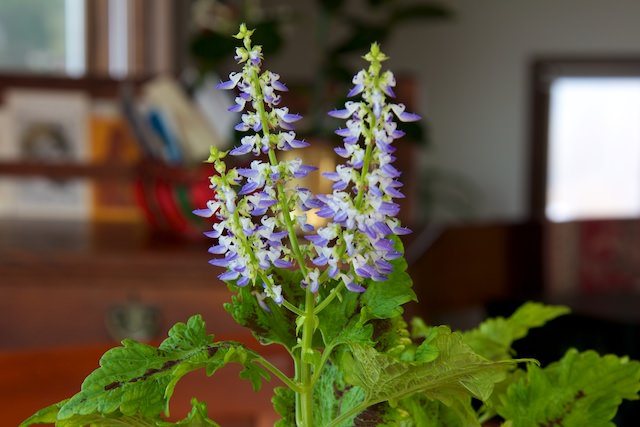

According to the shape of the foliage, the following types of coleus are cultivated:
- with split foliage;
- with crumpled foliage;
- standard varieties and hybrids;
- with elongated, cut and wrinkled leaves.
Among other things, it is possible to grow varieties and hybrids with erect and ampelous or hanging leaves in indoor conditions and on open ground flower beds.
How to care for a plant
Caring for Coleus at home consists of just a few basic rules that will provide the plant with full development:
- watering;
- placement;
- transfer;
- top dressing;
- pruning.
Now let's pay attention to each item separately:
Watering
When organizing the care of the Coleus that grows at home, you must immediately familiarize yourself with the watering rules.
With the arrival of spring and before the beginning of autumn, the plant is watered when the topsoil becomes noticeably dry. In winter, however, the volume of water should be greatly reduced, depending on what temperature will be maintained in the room.
It is advisable to use soft and settled water for irrigation. If possible, you can water the flower with rainwater. The lack of moisture in the soil will tell the grower the state of the leaves, there is clearly not enough watering for the plant, if the leaves begin to wither and become flabby.
Pouring Coleus is also not recommended, since the roots of this exotic plant are delicate and constantly need free access to air.
Excess moisture can have a very adverse effect on the plant, as water will occupy the pores in the soil, thereby limiting ventilation. As a result, the root system of the flower can rot and disappear.
Air humidity is also an important point, which should include caring for indoor coleus.
Noteworthy facts about the flower
- If Coleus grows on your window, no moth will be creepy for you. This plant promotes an atmosphere of cleanliness and does not tolerate living together with any parasites.
- On the leaves of Coleus, there are small bumps that make the role of lenses. Specifically, due to the reflected light from these natural lenses, the sheets have such a catchy color. If you want to check this fact, place the Coleus leaf in a glass filled with hot water. The tubercles will burst and the leaves will turn greenish, like all ordinary plants.
- You can change the color of Coleus leaves with water, to which food coloring is added. After you water the plant with such water, it will be very noticeable how it rises along the transparent stem.
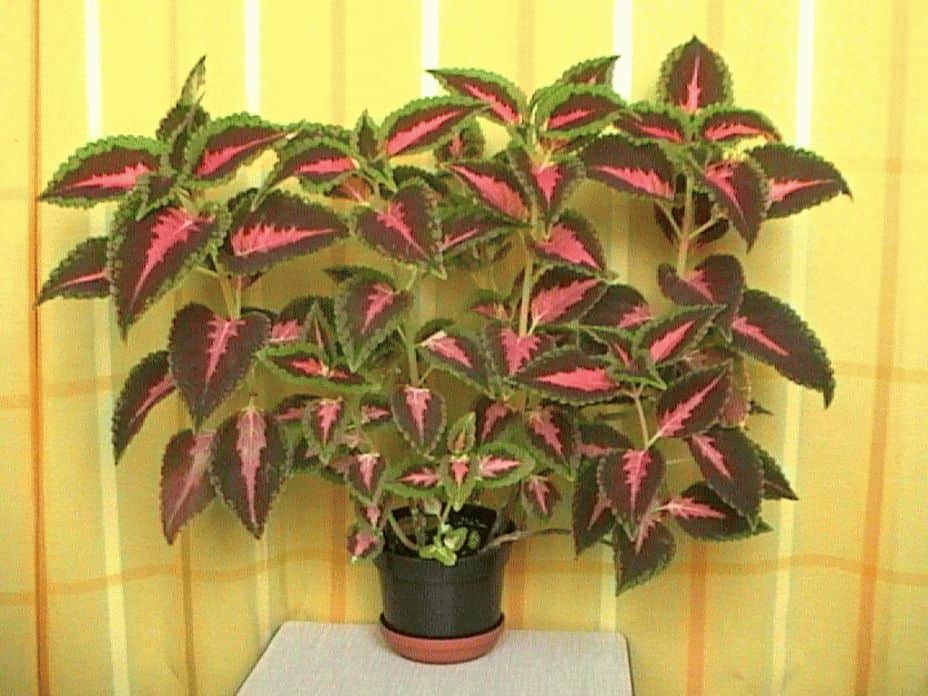

You will literally not regret it if you dare to have this unusual plant at home. It will fill your home and you with positive energy, attract good fortune in business and make you feel better.
Coleus - signs and superstitions
The plant is suitable for an increased level of humidity at home, so you can safely place it in the kitchen. It is in this room that humidity is present and it is always warm. Tropical "nettle" treats spraying very well. For spraying, you should also use soft water. It is desirable that its temperature be at room level.
Accommodation
Coleus, grown at home, provides for placing it only in well-lit places. The number of leaves of a plant directly depends on the lighting: the more leaves a plant has, the more light it needs.
In the summer, growing Coleus at home, its foliage should be protected from direct sunlight. In winter, you can safely place a flower on the lightest windowsill (see photo).
In the room where you decided to grow Coleus, the temperature should be from 16 to 25 degrees in summer, and at least 12 in winter.
It is better to prepare the soil for growing Coleus yourself. If it is possible to prepare an earthen mixture at home, in equal parts consisting of turf and leafy soil, peat, sand, this will be an ideal option.
Transfer
Coleus transplants require every 2 - 3 years. As previously mentioned, the roots of the plant are delicate and should be transplanted with extreme care. A clod of earth that may remain on the roots when transplanted into a large container does not need to be removed (see photo). This minimizes the risk of damage to the root system.
You should definitely take care of good drainage by covering the bottom of the pot with fine expanded clay or pieces of broken brick. The mixture that must be prepared for transplanting a plant should not differ from the previous one in composition.
Top dressing
Top dressing is provided for home-grown Coleus only in the spring and summer months. During these periods, the flower develops and grows more intensively.
Fertilizers must be of mineral or organic origin. Fertilizer maintenance is not carried out in winter.
Pruning
In winter, Coleus, unfortunately, loses its attractive appearance. Therefore, with the arrival of spring and the appearance of new shoots, it is worth pruning, which includes caring for an adult plant at home. Pruning will not only rid the bush of obsolete stems, but also form it. As a rule, pruning is carried out throughout the growing season. Coleus buds should also be pinched. This will provide the bush with a lush and abundant flowering.
This plant, which is not particularly difficult to care for, is an unusual and attractive flower in indoor conditions.
Botanical description of Coleus
Coleus belongs to evergreen shrubs and herbaceous annuals with opposite foliage on petioles. The leaves are distinguished by a variety of colors and original patterns. Flowers are collected in apical spike-shaped inflorescences. Unlike other tropical plants, Coleus of any varieties are characterized by almost absolute unpretentiousness, but in order to grow a highly decorative indoor plant, it is necessary to have a flower pot with the culture in bright rooms.
In the summer, a decorative flower can be kept on an open veranda, terrace, balcony or loggia. Coleus grows fast enough and blooms profusely, as a result of which it grows in a short time. Domestic growers often call it decorative nettle, due to the similarity in appearance.
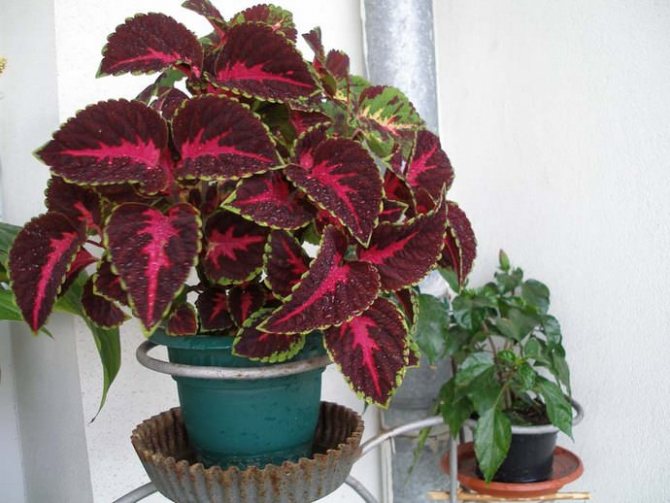

Flower urticaria
A native of the tropical latitudes of Africa and Asia, known to most housewives under the banal name "nettle", actually bears the sonorous name "Coleus". Experienced flower growers know that its numerous varieties, really similar to nettle in the form of foliage and bush, are able to create a real rainbow of colors on the windowsill of an ordinary apartment. After all, the colors of this exotic guest from the equatorial belt of our planet vary from salad and emerald green to amber yellow, pink and even burgundy. Moreover, various combinations of these shades on one leaf plate give a special decorative effect to the plant.
However, the addiction of flower growers to Coleus is explained not only by the ease of care and the spectacular appearance of the flower, but also by its many mystical properties. After all, the true benefits of nettles lie in their amazing ability to balance energy flows in the home, creating not just a positive, but even a healing aura.
Omens by the season
Coleus is characterized by seasonality of growth and flowering. According to his condition at different times of the year, our ancestors predicted the future:
- Unfavorable omen if nettles bloomed in winter... This means that you will have to experience financial difficulties. Possible negative situations at work, lower wages or the need to pay a fine.
- If a the plant blooms in summer, this portends a successful year for the owner. Blooming Coleus promises a quick profit. Healers for the preparation of infusions use nettle flowers only if the flowering takes place in summer.
- If a flower wilted in winter, which means that the summer will be difficult for the inhabitants of the house.
- Plant withered in spring, portends loneliness, discord in long-term relationships.
Esotericists advise to cut dry leaves in a timely manner, water the coleus, monitor the condition of the soil in order to avoid the death of the plant. At any time of the year, a healthy flower is a strong amulet for household members.


Good omens about Coleus
- The appearance of a tropical exotic in the room will certainly ennoble the energy space of the room. Households near the flower experience a surge of strength and positive emotions, get rid of worries and ailments, begin to think better and more often make the right decisions in difficult situations.
- Coleus is also a welcome guest for office space. After all, its positive impact attracts business success, helps to make a career, and maintains trusting and productive relationships between colleagues.
- The flowering of any plant with magical properties has a special meaning, exacerbating its positive or negative qualities. If the nettle has picked up buds at the right time (spring or summer), then you should prepare for positive changes in the life of the family or a career takeoff. However, the flowers that appeared in the winter should be alarming, since financial problems are highly likely to predict.
- Biologists find a completely scientific basis for the special "talents" of the Coleus. They found that the flower abundantly releases useful essential oils into the surrounding space, which have a beneficial effect on brain activity and the state of the human nervous system.
Where to put on Feng Shui
Feng shui experts advise placing the plant in a home where people are often discouraged, financially distressed, lazy, or unable to concentrate. Esotericists are sure that Coleus brings joy and attracts happiness.
Feng shui nettles are placed in the northeastern zone of the room. Better in the room of a student or schoolchild, as the flower enhances mental abilities, increases concentration and efficiency. According to the signs, the plant is appropriate in the office, where important decisions are often made.
If troubles often occur in the house, then the Coleus can be placed in a green pot in the hallway, closer to the door. As soon as the situation improves, you can rearrange the plant to its usual place.
According to signs, Coleus absorbs bad energy and cleans the space, improving the quality of life of the residents of the house.
Bad beliefs about nettles
In addition to numerous good signs about Coleus, there are many negative superstitions that prohibit the cultivation of this guest from the tropics in the house.
- One of the most popular interpretations of the content of a variegated flower in a house predicts that its owner will soon be "broke". Most likely, such a belief appeared in those days when the presence of ordinary nettles on the windowsill was a sign of low income. After all, wealthy citizens could afford more spectacular exotics like croton, dracaena or yucca.
- Superstitious people classify Coleus as numerous. Often, the divorce or widowhood of a woman, the inability of a girl to find a loved one and become a married lady is explained by the presence of a tropical flower with bright leaves in the house.
- So the saturated purple shades in the color of the leaf plates that attract many flower growers have served the nettle a bad service. Thanks to them, the plant is credited with the ability to attract fires to the house. Therefore, if you are afraid of losing your property in a fire, never grow this exotic on the windowsill.
Can I keep at home
An ornamental houseplant is placed on a sunny windowsill, watered if necessary and get rid of dried leaves.
Nettle's reputation has been tainted by a decades-old belief that only the poor could grow it. Superstitious people argue that Coleus can deprive the owners of wealth, lead to financial difficulties, so you cannot keep it at home.
In Asian countries, nettles are planted at the graves, calling it a plant of the dead. The source of unfavorable energy is associated with fire, believing that the flower leads to fires in the apartment. Modern esotericists refute the negative effect of Coleus, highlighting its healing properties.
The plant is not poisonous, does not exude strong odors, so it can be grown even in a house where there are allergies. If small children or pets live in the apartment, the nettles must be placed in a place inaccessible to them. The juice in the leaves can cause poisoning if a curious child or cat eats a couple of the leaves.
What does a sick Coleus warn about?
Nettle owners should pay special attention to the condition of the plant and proper care for it.
- If, despite proper care, your specimen suddenly begins to wither, dry and shed leaves, you should pay attention to the atmosphere in the house. Most likely, due to constant conflicts or strong feelings of household members, so much negativity has accumulated in space that the plant simply cannot cope with its neutralization. It is necessary to urgently change something in the relationship and look at life with greater optimism.
- It happens that careless owners do not seek to pay attention to the flower, forgetting not only to loosen the soil and feed, but even water the plant on time.Such neglect can turn vengeful Coleus against you, filling the home space with negative energy, leading to illness and trouble.
- It is worth remembering that the best remedy for any disease of nettles will be not only its active "resuscitation" with the help of intensive care and manipulations that cleanse the home aura from negativity. The flower and the family atmosphere will benefit from an extraordinary vacation with a trip to a warm region. Thus, the plant will be able to restore its vitality in your absence, and the household will rest and relax, strengthening their health and filled with positive emotions.
VN: F
See also: Signs about flowers
Rating: 0.0 /5 (0 votes cast)
The cultivation of coleus, a herb that looks like nettles, is found in our area quite often at home. Even though the plant came to us from the tropical regions of Asia and Africa, caring for it is not difficult and will give quite delightful results in the form of healthy and saturated bushes.
Selection of indoor plants for residential premises
There are two ways to pick up flowers for the house, according to the rules of Feng Shui: those that you want to have, adding to them those that are necessary in the living space or area near the place of residence.
So, flowers useful to humans, according to the followers of Feng:
- geraniums and chrysanthemums contribute to reconciliation between the warring parties, help to find a compromise;
- the violet soothes the emotionally saturated child's psyche and the adult also during the period of educational moments;
- a fat woman (popularly, a money tree) helps to establish the financial sphere of the inhabitants of the house;
- golden mustache - healer, heals wounds;
- ficus directs energy to solve accumulated problems, especially between, according to the fen teachings;
- aloe keeps the relationship between spouses, other family members;
- Coleus can cause passion between lovers or established married couples.
It should be remembered, the followers of fan science advise, plants, like all living, inanimate nature, are subject to the influence of the elements. Therefore, it should be arranged in the house according to the element to which they relate. They will work right for a person and will also contribute to all kinds of success.


Plants that like the bright sun can activate the sector of Glory, where the element of fire reigns. They have a beautiful vibrant color. These are flowering cacti, gerberas, oleanders, geraniums, coleus, hibiscus, gloxinia. But give up tall flowers with leaves - arrows. This is important from a feng practitioner's point of view.
The elements of metal in the zones of Children and Helpers are characterized by flowers with light leaves and inflorescences. Some have medicinal properties that can awaken passionate relationships. These are primrose, Kalanchoe, gardenia, jasmine, begonia, violet, cyclamen, aloe, fat woman, ficus, citrus fruits.
For the elements of the earth in the Knowledge sector, flowers of yellow shades are suitable: hydrangea, tea rose, aster, orchid. The role of flowers in relation to a person in Feng Shui helps to build relationships between family members, bring material stability, and improve emotional health.
The element tree in the zones of Family and Prosperity supports most plant species, except for the unpredictable chlorophytum, aralia, yucca, and some others.
Plants of the water element in the Career sector grow well in dark areas of the house, they like abundant watering, good care. Promote creativity, improve family ties, and reduce quarrels. These are asparagus, dracaena, lilac violet, camellia, iris. But choose carefully, some bring depression, depression.
general description
Coleus home, which is commonly called Hybrid, is a lush shrub. Its leaves, as a rule, have an oval shape with a dissection along the edges, resembling small cuts (see photo). It is the leaves that form the flower, since they have a variety of colors and always have a rich color.Almost always there are "patterns" on the leaves that give the plant an exotic and spectacular look.
Coleus is grown both at home and outdoors. It is customary to arrange flowers in the room on the windowsills, while in the open air, Coleus is planted as an annual. In indoor floriculture, such flowers are valuable due to their variegated color.
Home Coleus leaves velvety to the touch, but with a variety of shades. Therefore, it is difficult to identify this plant at first glance. In indoor floriculture, there are plants with purple, red, yellow, pink and even purple leaves, as in the photo.
Signs on the state of the flower
Nettle is an indicator of a person's thoughts and energy. By the state of the plant, you can determine what atmosphere reigns in the house, which threatens its residents:
- If a person with evil approaches the Coleus, then the leaves will begin to curl, fade.
- Being in an apartment where peace and quiet reigns, the plant blooms.
- Dried leaves symbolize illness and grief. If the nettle is dead, then it is taken out of the house along with the pot.
- If the leaves of the Coleus turn yellow, then this is a warning about impending problems that cannot be dealt with alone.
- If the yellow leaves curl or fall off, it means that the family has been damaged. According to signs, the source must be looked for in the apartment. It can be any unfamiliar object, a needle or pin stuck into the furniture. The lining is not taken with bare hands, only with gloves, and then they must be taken out of the apartment.
According to signs, if the nettle withers next to other flowers, it warns of the appearance of an enemy. You need to put the plant in another place, providing a lot of light.
If the coleus bloomed
Esotericists love this flower for its special magical properties. The plant absorbs black magic like a sponge, converting it into light energy. It is useful to have a bright bush at home that can protect household members from external magical influences.
According to signs, Coleus blooms for a favorable outcome of an important event. Blooming foreshadows good luck, financial well-being and an organized life.
If this flower bloomed in winter - expect trouble and money problems.
Blooming Coleus needs energy support, it is useful to devote more time to it and to talk. It is believed that blooming in mid to late summer promises wealth that will come in the coming winter.
If the flower has started to fade
It is a bad omen if the coleus began to fade before our eyes: it turned yellow, dried up and eventually died. This could mean the following:
- impending financial problems;
- soon one of the tenants will get sick;
- there is an excess of negative energy in the apartment.
Read also How to fry butter in a pan with onions
A wilting plant is incapable of harming humans. And the dead and dried up Coleus will draw out vitality, the residents will have headaches, fatigue, insomnia, depression. Better to get rid of dead wood.
According to signs, a wilted plant indicates a hidden ailment: you need to check your health or start treatment if the first symptoms have already appeared.
When Coleus lives for a long time with one owner, then the appearance of the plant is an indicator of the owner's health.
How to care for a plant
Caring for Coleus at home consists of just a few basic rules that will ensure the plant's full development:
- watering;
- placement;
- transfer;
- top dressing;
- pruning.
Now let's pay attention to each item separately:
Watering
When organizing the care of the Coleus that grows at home, you must immediately familiarize yourself with the watering rules.
With the arrival of spring and before the beginning of autumn, the plant is watered when the topsoil becomes noticeably dry. In winter, however, the volume of water should be greatly reduced, depending on what temperature will be maintained in the room.
It is advisable to use soft and settled water for irrigation. If possible, you can water the flower with rainwater.
Landscaping use cases
In modern landscape design of a personal and suburban area, not only expensive and rare flowering plants can be used. In recent years, perennial or annual coleus flowers, which are most often grown as an indoor crop by many growers, have become very popular in home gardening. Well-growing bushes of Coleus are completely unpretentious, and when grown in sunny areas, they look very decorative and attractive.
Despite the fact that, under the influence of high-quality lighting, the coloring of the foliage of this decorative culture, regardless of the variety, becomes as bright and effective as possible, plants with white, whitish or red leaves perfectly tolerate even direct sunlight, but varieties with green foliage may require shading in especially sunny days. Coleus are planted in small group plantings, represented by a combination of various shades of decorative foliage.
Coleus flower in signs
The lack of moisture in the soil will tell the grower the state of the leaves, there is clearly not enough watering for the plant, if the leaves begin to wither and become flabby.
Pouring Coleus is also not recommended, since the roots of this exotic plant are delicate and constantly need free access to air.
Excess moisture can have a very negative effect on the plant, as water will occupy the pores in the soil, thereby limiting ventilation. As a result, the root system of the flower can rot and disappear.
Air humidity is also an important point, which should include caring for indoor Coleus. The plant is suitable for an increased level of humidity at home, so you can safely place it in the kitchen. It is in this room that humidity is present and it is always warm. Tropical "nettle" treats spraying very well. For spraying, you should also use soft water. It is desirable that its temperature be at room level.
Accommodation
Coleus, grown at home, provides for placing it only in well-lit places. The number of leaves of a plant directly depends on the lighting: the more leaves a plant has, the more light it needs.
In the summer, growing Coleus at home, its foliage should be protected from direct sunlight. In winter, you can safely place a flower on the lightest windowsill (see photo).
In the room where you decided to grow Coleus, the temperature should be from 16 to 25 degrees in summer, and at least 12 in winter.
It is better to prepare the soil for growing Coleus yourself. If it is possible to prepare an earthen mixture at home, in equal parts consisting of turf and leafy soil, peat, sand, this will be an ideal option.
Transfer
Coleus transplants require every 2 - 3 years. As previously mentioned, the roots of the plant are delicate and should be transplanted with extreme care. A clod of earth that may remain on the roots when transplanted into a large container does not need to be removed (see photo). This will minimize the risk of damage to the root system.
You should definitely take care of good drainage by covering the bottom of the pot with fine expanded clay or pieces of broken brick. The mixture that must be prepared for transplanting a plant should not differ from the previous one in composition.
Top dressing
Top dressing is provided for home-grown Coleus only in the spring and summer months. During these periods, the flower develops and grows more intensively.
Fertilizers must be of mineral or organic origin. Fertilizer maintenance is not carried out in winter.
Pruning
In winter, Coleus, unfortunately, loses its attractive appearance.Therefore, with the arrival of spring and the appearance of new shoots, it is worth pruning, which includes caring for an adult plant at home. Pruning will not only rid the bush of obsolete stems, but also form it. As a rule, pruning is carried out throughout the growing season. Coleus buds should also be pinched. This will provide the bush with a lush and abundant flowering.
This plant, which is not particularly difficult to care for, is an extraordinary and attractive flower in indoor conditions.
Superstitions about this flower
Superstitions are false connections between subjective (that is, those that depend on a person) events. As a rule, they are supported by isolated cases of coincidence or fitting of events to the desired result.
With the advent of Coleus in our people, a sufficient number of superstitions about him arose:
- It is not recommended to keep the flower at home, for he, according to superstition, is capable of making a person bankrupt. The roots of this prejudice go back far into the past, when Coleus or "nettles" was called croton for the poor. Croton looks very much like a nettle, but it has a higher cost and a rather complicated self-care.
- The bloom of Coleus in the winter season portends poverty. In ancient times, it was believed that if a houseplant begins to bloom in winter, it can promise hunger. This was explained quite simply - it was usually very cold in houses in winter. And if a houseplant that stood on a cold window suddenly bloomed, this meant that the winter was warm enough, which meant that there was little snow outside and the crop could die. Today all apartments are equipped with heating, the windows are insulated for the winter, or they have double-glazed windows. Therefore, a warm-loving guest from a hot tropical state can flourish at any time of the year and you cannot blindly trust this superstition.
- Quite often, this plant is referred to as muzhegon. That is, if a single girl gets Coleus, the suitors will "run away" from her. In this case, the superstition is explained by the "deaf telephone". Since ancient times, Coleus was considered a fly-eater, since flies and other pests did not land on it.
- If Coleus grows in a dwelling, a fire may occur in it. This superstition is most likely due to the bright leaves of the plant, which from the outside look very much like a small flame. But if you are too impressed with this superstition and cannot get it out of your head in any way, it is better not to keep the flower at home, so as not to attract unhappiness on a subconscious level.
Nettle will decorate the windowsill
Date: 09/10/2010 | Section: Flowers at home |


It is very popular with many florists. coleus... Indoor nettles with beautiful leaves decorate not only windows, balconies, but also garden plots. The color of the leaves of Coleus varies from light yellow to dark purple with intricate patterns: specks, specks, veins or contrasting borders. For those who like to see flowers at home in a wide variety, Coleus is a godsend. Plant height usually ranges from 30-50 cm, sometimes up to 80 cm.
Coleus belongs to the family Lamiaceae. His homeland is the tropics of Asia and Africa. We are accustomed to the beautiful nettle with its leaves. But there are also flowering species of Coleus (for example, C. Frederici). The name of this plant comes from the Greek word "kleos" - case, scabbard. It is generally believed that this name came about because of the structure of the flower: the pistil is hidden in the accrete staminate threads, like a blade in a scabbard. The structure of the leaves and stems resembles nettles - only without thorns and very beautifully colored. Hence the popular name of the plant - indoor, or colored, nettle.
For Coleus, a mixture of turf, leafy soil, peat and sand in equal parts is best suited. But Coleus grows normally in ordinary soil from a garden plot.Coleus needs a moderate temperature in summer, cool in winter. At temperatures below 13 degrees, Coleus can die from root rot.
Coleus are light-loving plants: the compactness of the bush and the brightness of the leaves is preserved only in the presence of bright diffused light. With a prolonged lack of light, the leaves turn from variegated green. However, Coleus does not tolerate direct sun - its leaves wilt. If the weather is cloudy for 2-3 days, then the leaves turn pale, and in sunny weather they are striking in brightness and multicolor.
Due to its photophilousness, the plant quickly stretches out in winter. Pulling of the stems and discoloration of leaves in winter is difficult to avoid even with additional lighting. In summer, coleus must be watered abundantly: they evaporate moisture very strongly, and if they do not have time to replenish its supply, the leaves fall and become flabby. In winter, in conditions of lower temperatures and a decrease in daylight hours, watering is reduced. Soft water is preferable. Regular pruning or pinching is indispensable: otherwise, the plant will quickly lose its shape. In the spring, the plant is either cut off strongly, leaving "hemp" 5-7 cm high (new bright young shoots will grow on them), or renewed - the cutting is rooted, and the old plant is disposed of. After pruning, watering is sharply reduced for a while.
Benefits and harm in the house
Coleus, like any indoor flower, can be both beneficial and harmful to households.
The benefits of Coleus at home:
- Due to the unusual color of the leaves, Coleus gives the interior a bright extraordinary look.
- Essential oils secreted by it are able to purify the energy of the house, expelling everything negative.
- The pleasant scent of a flower, reminiscent of mint, promotes clarity of mind, increases efficiency, improves memory.
- It is believed that this flower in the house is a great way to get rid of diseases.
- Coleus is able to bring good luck, money, prosperity to the house.
- The plant can help the household to "figure out" the ill-wisher: if a person comes into the house with malicious intent or unkind thoughts, the Coleus will show this - its leaves will begin to fade.
Harm of Coleus at home:
- A flower can drive men out of the house. So for single women who believe in omens and superstitions, it is better to refrain from such a "pet".
- A flower can bring troubles and illnesses with it to your home.
- There is an opinion that Coleus in the house is a sign of ruin, poverty.
Some signs contradict themselves, so everyone chooses to believe in them or not.
Signs about Coleus
For fast growing varieties, re-pruning is possible in mid-summer.
Coleus can be fed every 10-14 days from March to August, alternating mineral and organic feedings. Any dressing should be preceded by abundant watering with clean water. Since the homeland of Coleus is tropical forests, it needs frequent spraying. You can place the plant pot on a pallet with wet pebbles or expanded clay. A twig cut and placed in a vessel with water in sunny weather will give roots sufficient for planting in a pot in a week.
It is best to propagate coleus in the spring, but, as a last resort, you can do this at any time of the year. Lovers grow Coleus from seeds. They are rarely planted in flat dishes in early spring, moistened, covered with glass and placed in a warm place. After the pick, the plants are pruned several times and by the summer they get a full-fledged bush.
If the room is too warm and dry, a spider mite can attack the plant. Mealybugs, aphids and whiteflies love coleus. To combat them, insecticides are used.
For planting in the garden, stable small-leaved forms are often used. If you decide to move the Coleus to open ground, then you should remember that this can be done only after the summer heat has been established. In the fall, the plants must be taken into the house before the first frost.
When preparing the text, I used recommendations from old magazines that once helped me to comprehend the basics of floriculture.
Alexandra Sobolevskaya, website
Did you like the article? Subscribe to receive updates by email or RSS
Subscriptions
Subscribe to
"The first bed" will allow you to receive all the latest articles on e-mai weekly:
(published in the magazine "Household economy" No. 7, July 2004)
Deaf nettles are found throughout the northern hemisphere, except for the desert zone. Deaf nettles grow in deciduous forests, on forest edges, in bushes and in gardens next to housing. Sometimes it is confused with nettle and bypassed, but it does not burn. But traditional healers highly value the white flowers of this so-called deaf nettle.
A modest wild plant is more correct to call clear white (Lamium album). If you pluck and knead its leaf or stalk with your fingers, you will immediately feel the typical "labiate" smell. By the way, lamb is a plant that gave this family its name in the new botanical nomenclature. Now it is called that - luciferous.
All the signs of the family are clearly visible on it - a tetrahedral stem, opposite leaves arranged in pairs crosswise, pubescence covering the plant. A peculiar nettle flower with two lips resembles the head of a fabulous beast with an open mouth. The corolla tube is short, curved, hairy inside. The upper lip is rounded and convex, overhanging the flat lower lip.
A lot of nectar accumulates at the base of the corolla. Try, ahead of the bee, pick the newly opened white or slightly yellowish nettle flower and suck it at the base: the nectar will immediately be on your tongue, and you will feel a pleasant sweetness.
Flowers are considered to be a medicinal raw material for nettles. They contain large amounts of mucus, essential oil, saponins, choline, histamine, tyramine, tannins, vitamin C and traces of alkaloids.
How to trim Coleus (video)
Cuttings
Cutting is one of the most convenient ways to propagate an ornamental culture on your own. Planting material can be very easily obtained by pruning already adult or overgrown Coleus. Cuttings of high quality and suitable for obtaining a new young plant should be 10-12 cm long. In preparation for planting, the leaves should be removed from the bottom of the cutting.
Rooting of cuttings is carried out in moist soil or moist coarse sand... Cuttings during rooting should be covered with clear plastic or a cut plastic bottle. Until complete rooting, plants need to provide a temperature regime of 18-20 ºC, which will allow the root system to form in about ten days, after which young coleus can be planted in a permanent place. This reproduction is not only very simple, but also very reliable.


Seeds
Plant propagation by seeds is very simple, which makes it a fairly popular method among amateur flower growers in our country. Reproduction of indoor ornamental culture with seed material is carried out in the same way as the cultivation of a garden coleus. Almost all varieties of Coleus have the highest level of seed germination. When sowing seeds, mass shoots appear in about a week and a half. Before emergence, planting should be covered with glass or transparent polyethylene.
After the emergence of shoots, the shelter must be removed and the plant installed in a place with good lighting. Optimum indicators for cultivating Coleus are temperatures within the range of 20-24 ° C. You need to dive seedlings at the age of one and a half months. At this moment, the crown of young plants must be pinched. As soon as the threat of late spring frosts has passed, seedlings of an ornamental culture can be planted in the garden.
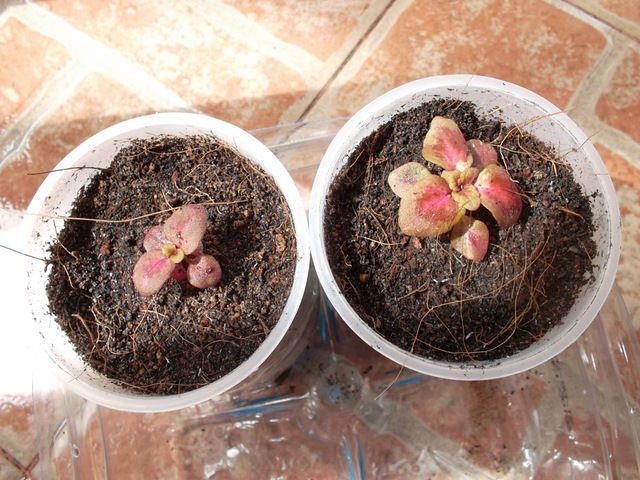

If the flower has started to fade
Changes in the appearance of room nettles indicate unnecessary negative effects received by it.Most often, an exotic flower begins to wilt and dry out when the energy situation in the room is so full that it cannot cope with it.
The owners attribute such changes in home nettle to inadequate care.
If a flower begins to dry up for no apparent reason, this, according to signs, portends the approach of an illness in one of those living in the house.
Seed propagation method
With seed propagation, it cannot be guaranteed that the coleus will inherit the characteristics of the parent plant. The best time to plant seeds is March. The soil for sowing is prepared from three parts of leafy land, one part of sod land and one part of sand.
Before sowing, the seeds are disinfected. The most affordable method is to soak the seeds in a weak solution of potassium permanganate for 25 minutes. Potassium permanganate can be replaced with any industrial growth stimulant. If you prefer folk remedies, then you can take garlic or aloe juice as stimulants.
It should be noted that after disinfection, the seeds need to be thoroughly dried! Coleus seeds are planted in slightly moist soil to a depth of no more than 4 mm. Next, we build a mini-plaque. The temperature in the room where the seeds are grown should be 22-25 ° C. Seedlings will delight the eye in a week.
Seedlings of home nettles are demanding on lighting. Choose a location with diffused light for the sprout container. With a lack of light and lack of additional lighting, the seedlings will begin to stretch and weaken. Do not forget that the mini-plate needs regular ventilation.
After 2 weeks, the shoots of Coleus must be fed. For this, complex fertilizers are used, and the recommended dose is reduced by 3-4 times. After the first true leaves appear, the plants can be dived. Six months later, the seedling will reach the size of an adult flower.
Superstitions associated with Coleus
Superstitions are called false connections between subjective (depending on the person) events... These prejudices are reinforced, as a rule, by a single coincidence or by adjusting the event to the expected result.
Thanks to Coleus, the following superstitions appeared among the people:
- The plant cannot be kept at home, as it leads to poverty. This prejudice came from the fact that coleus, or "nettles", was initially called croton for the poor. Croton is very similar to "nettles", but very expensive and extremely whimsical.
- If a Coleus bloomed in winterthen family poorer soon... In ancient times, if a houseplant began to bloom in winter, then this, indeed, could promise famine to a peasant family. The fact is that houses were poorly heated in winter. If an indoor flower standing on a cold window bloomed, it means that the winter was warm, the snow cover was scarce, the winter crops could freeze everything. Currently, all apartments have central heating, windows are insulated for the winter or double-glazed windows are installed. Consequently, a thermophilic guest from hot countries, such as Coleus, can bloom at any time of the year.
With coleus in the house there may be a fireSuch a prejudice can only be explained by the bright color of the leaves of the plant, which, from the outside, really resemble a small fire. If this superstition is firmly entrenched in the mind, then it is better not to keep the Coleus at home.
The positive effects of Coleus
As noted above, many omens and superstitions endow Coleus with the ability to improve the atmosphere in the house, restore damaged energy. But this flower can be used for other purposes as well, using its extraordinary abilities.
Nettle can be kept at home as a fortuneteller. The state of the plant is used to judge what lies ahead. If, with good care, he begins to dry out, get sick, then someone in the family will soon undergo illness. This sign is explained quite simply. Coleus is able to withstand any poor energy conditions.If he is moping, then the situation at home is much worse than average. And in such conditions, it is simply impossible for a person to remain healthy.
If the nettle is withering away, it is better to go on vacation, rest, not neglect preventive measures so that the disease does not take over the body.
The second important property of this flower is the ability to attract good luck in business. To do this, it must be installed not at home, but at the workplace. The essential oils secreted by this plant activate the brain and increase creativity. The positive energy that this flower has, protects envious people and enemies from the crafts, in a timely manner neutralizes all negative messages to its owner.
Positive beliefs
As if the colorful leaves that shimmer in the light are able to attract fire. Naturally, such superstitions are not at all conditioned, but nevertheless, if you are very suspicious, it is better not to acquire such flowers. There are signs depending on the time of year when you have a perennial appeared or blossomed:
Harbinger of the seasons
This is about the moment when you put your whole soul into your favorite plant, and rather than because of events you simply forgot to water the flower, then there is no need to complain. The homeland of the plant is Asia and the African continent, it needs a lot of light and heat. Therefore, if Croton is not given proper care and attention, he will wither. There is also a worldview that, according to the signs, the Flower is a cemetery flower and will bring misfortune and death to the family. The leaves of the plant emit a special smell into the atmosphere, somewhat similar to mint. This smell has been proven to stimulate the brain and promote fruitful work.
If your plant decides to please you by releasing its buds in the fall, it is very lucky for you - this is a good symbol. The sign says good luck smiled for you, you can safely start new business and be convinced that they will be crowned with success.
Foreshadowing for women
Popular beliefs say about the bad effects of a flower at home. Keeping Croton as a houseplant should not be due to the fact that it will take away strength and energy from a person. Also, the plant brings trouble to its owners, if they forget to water it or do not expose it to the light. Keep in mind this sign and, rather than you have a dark streak in your life, maybe you forgot about your own flower.
Coleus: characteristics and appearance
- Stems are woody at the base, erect tetrahedral.
- Leaves - oval-ovate pubescent with denticles, elongated with fringed edges, leaf length from 15 cm, in structure there are varieties with dense leaves, or vice versa, very delicate.
- Panicles - small purple-blue flowers, inconspicuous, occur under unfavorable conditions. Such flowering takes a lot of extra energy from the plant, so the arrow is immediately removed.
- Height - from 30 cm to 50 cm.
Negative influence
Many people in the house plant nettles. In most cases, they do this out of a desire to admire its exotic appearance, original red-green leaves. If the plant is poorly cared for, the amount of red on the leaves will decrease. Otherwise, they may dry out and fall off altogether.
This should not be allowed, because superstitions endow Coleus with the ability to take revenge on their masters. Revenge happens if the owners pay little attention to their green pet. In order not to blame the flower for its illnesses and failures. It is better to water it in a timely manner, feed it, and carry out the necessary pruning.
Superstition
For all its capricious nature, Croton, in general, has a beneficial effect on a person. Therefore, coleus, omens and superstitions, concerning him, reflect the diverse mood and ambiguous opinion prevailing among the people. The list of superstitions is extensive:
- "Do not plant a flower at home, you will become bankrupt." The roots of this view have a historical past.In England, the name "croton for the poor" initially took root. Previously, only wealthy people could afford to buy the seeds of an exotic guest.
- Blooming in winter - to poverty and lack of money. Indoor flowers were placed mainly on windowsills. In cold weather the glass was covered with frost from the inside, so the "spring" on the windowsill began simultaneously with the arrival of heat. In a warm winter with little snow, Coleus bloomed earlier. But the lack of snow threatened a bad harvest, and, as a result, hunger. Today, common superstition cannot be trusted. Double-glazed windows have good insulation, heat-loving croton blooms at any time.
- Croton is "muzhegon". The effect of a “damaged phone” has worked. The original variant is "fly-eater", flies do not tolerate the smell of essential oils secreted by the shoots. This has nothing to do with the men who supposedly run away from the owner of the plant.
- If you grow Coleus at home, there will be a fire. Evil tongues attribute this property to the flower because of the crimson color of the leaves. Superstition does not go out of my head? It is better to take the pot to the office so that you do not subconsciously attract unhappiness to yourself.
Related Videos
How to grow nettles and care for a houseplant:
With proper care and attentive attitude, the Coleus will delight the owners for a long time with its beautiful appearance and a beneficial effect on the home atmosphere. He quickly gets used to new conditions, if he has enough light and moisture, gets along well with other plants and gets used to his place.
Coleus is a tropical and very beautiful flower, which also becomes a wonderful interior detail. Fans of houseplants can safely acquire this adorable friend.
How to deal with pests?
Insects harmful to Coleus include:
- whitefly;
- spider mite.
You can fight pests with industrial drugs or folk remedies. Well-proven store drugs include:
- Actellik;
- Apollo;
- Fitoverm;
- Akarin;
- Oberon;
- Agravertine.
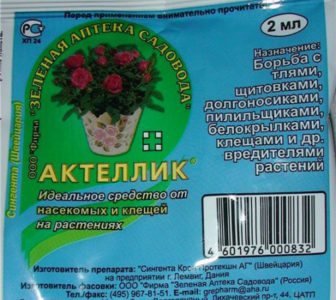

Effective folk methods of combating aphids include spraying an infected plant with soapy water. For its preparation, 300 g of household or 125 g of liquid soap is taken and diluted in 10 liters of water. Processing is done every 10 days during a month. During this procedure, the earthen ball should be covered to protect it from soapy water.
Folk omens
Signs are two or more objective (not dependent on the person) eventsfollowing each other. In this case, the initial event is perceived as a signal or sign before the next one occurs. In connection with the Coleus, some signs arose among the people.
If a coleus starts to wither and wither for some unknown reason, then soon one of household members get sickSuch a sign has some basis under it: if such a strong plant begins to mope, then the house needs a thorough cleaning, and households should pay close attention to their health. Perhaps you need to take a short vacation and recuperate.
If a coleus keep in the office or at work, then he will bring good luckThis omen is quite justified, since the plant perfectly cleans the space of negativity, neutralizes unnecessary extraneous influences.
In addition, the leaves of the flower are capable of releasing a specific essential oil into the air of the workroom with a faint odor, reminiscent of mint. On a subconscious level, the fluids of this oil activate the brain, prompting it to creative work.
Why can't you keep it at home?
- Grannies are not advised to put this plant in their home. Breeding it is considered a bad omen. They say that the second name of this plant is Poor Man's Croton. And therefore, it brings with it a lack of money and a terrible need.
- It is not recommended to plant it in your house or near it also because a fire can bring it with you.
- And Coleus cannot be placed in the house, because it is a cemetery flower, so it can bring the atmosphere of death to your house. He can often be seen on graves.
- It is also not recommended to put Coleus in the house because it is considered a poisonous plant. At least that's what our ancestors said.
What is Coleus?
- Coleus looks like a small shrub. It grows no longer in height, but in width. He scatters branches with dense foliage on the sides.
- The leaves of this plant resemble nettle leaves. And the color of Coleus can be completely varied. Most often, red Coleus is found in our area. It also comes in purple, yellow, pinkish, black and green.
- They plant him not only at home, but also to the balcony and even on a personal plot. This plant looks very beautiful and you can create unusual compositions from it. All this is due to the fact that Coleus has a beautiful color and does not require special personal care.
Not only decor, but also the benefits of Coleus
- Decorating the room. Indoor plants add extraordinary beauty to it. You want to approach the flowers, touch and even talk. Gardeners say that with affectionate communication with a flower, the plant begins to grow faster, and pleases the owner every day.
- Bright extraordinary appearance of the room. Coleus is a very variegated original plant. Possessing a large contrasting sheet, Coleus adds color and comfort to the room.
- A living corner in your home. Coleus is combined with absolutely all colors, looks advantageous against their background, although it has no colors. The air is clean and fresh thanks to living green plants.
- The ability to use the plant as a medicinal dietary supplement. Coleus can be used for medical purposes to normalize metabolic functions in the body.
Why does it bloom?
Coleus flowers do not differ in brightness and attractive appearance. But it is precisely many superstitions are associated with the flowering of the plant about material well-being, personal life and women's fate:
- The appearance of buds in early spring promises the mistress of the house happiness in her personal life, a meeting with new love.
- Coleus blossomed for the second time in a year - soon marriage.
- Flowers on fiery nettles blossomed on the eve of Christmas - the new year will not bring the expected profit and good luck in business.
- Abundant flowering in summer - good luck will accompany in all spheres of life.
- For the first time in a long time, buds appeared on the nettle - to the birth of a child.
- Coleus flowers blooming in May are considered to be the harbingers of good news soon.
And a little about secrets ...
Have you ever experienced unbearable joint pain? And you know firsthand what it is:
- inability to move easily and comfortably;
- discomfort when going up and down stairs;
- unpleasant crunching, clicking not on their own;
- pain during or after exercise;
- joint inflammation and swelling;
- unreasonable and sometimes unbearable aching pain in the joints ...
Now answer the question: does this suit you? How can you endure such pain? And how much money have you already "poured" on ineffective treatment? That's right - it's time to end it! Do you agree? That is why we decided to publish an exclusive interview with Professor Dikul, in which he revealed the secrets of getting rid of joint pain, arthritis and arthrosis.
Prejudices to watch out for
Coleus, signs and all the superstitions associated with these flowers are quite true. Any owner of these leaflets can tell about this. Let's start with the fact that when you look for plant seeds, you will hear that these flowers should never be grown and kept in the house... The funny thing is that most people do not understand and do not know why this should not be done, but they strongly believe in this theory.
According to one version, which allegedly confirms this statement that coleus leaves, poisonous... But, this version does not stand up to any criticism. The plant is completely safe for the health of all household members. Why such a prejudice has developed, no one can understand either.


mistika.
Features and properties of coleus
Juicy, red-brown leaves with a green border on the sides, give the decorative plant a special showiness. Coleus is unpretentious: not picky about moisture, does not need frequent feeding. Grows best in lighted areas. Active vegetation is observed after pinching.
It came to the European part from Asia, from where its seeds were exported several centuries ago. In Russia, the popular name is common - nettle, which the Coleus received for its external resemblance to its distant relative, the deaf nettle.
Along with positive characteristics, the flower has a number of negative properties. For example, she takes revenge on her family for lack of attention, poor care, indifference. Attracts negative energy, illness, minor troubles.
Superstitions about the dangers of Coleus
Not all superstitions see only good in Coleus. There are beliefs that forbid keeping this flower at home. There are several reasons for negative attitudes:
- Superstitions convince that a person who breeds Coleus is sure to go broke. The origins of superstition are in the historical past. Previously, this flower was grown by poor townspeople, and in the houses of aristocrats, a bright representative of the plant world, croton, was adorned with an arc, which was expensive, so it was not available to ordinary people.
- It is believed that nettles play the role of muzhegon. This means that the absence of men in the house can be associated with the repulsive effect of the plant. By the influence of indoor plants, many women explain their female misfortune: the loss of a spouse, the inability to get married, find a family.
- The third belief is very strange. Not growing this flower in your home is a popular way to protect yourself from fires. This parallel is due to the color of the plant. Each leaf has a deep red color, therefore, in the popular mind, it is associated with fire.
Testimonials
Katya: A neighbor saw a coleus on my window and said that now, they say, I would stay alone and live in poverty. It's been two years now. I got married, my daughter was six months old, we bought a car. We admire the Coleus.
Asya: When we moved our office, they gave me Coleus. Bright, so cheerful. When I brought him home, my mother-in-law was so outraged! It turns out this is muzhegon. It's good that my husband stood up. He said that he was in an apartment, so he would not be able to expel him. BUT the flower does not drive women... So it has been growing with us since then.
If you like Coleus and you treat it with proper attention and love, then all negative beliefs associated with this flower will turn out to be a myth. Passionate, independent, creating a great mood and harmonious atmosphere in any room, Coleus is always will reciprocate the care and a warm attitude.
Beliefs for women
Signs and superstitions about Coleus for women are aimed at family happiness and relationships:
- If it has bloomed in a childless couple, it means that it will soon be replenished.
- It is better for a lonely girl not to start such a plant, as it will scare away partners.
- If a couple starts a life together, then Coleus will protect them from gossip and misinterpretation.
- Fading nettle portends a woman's illness.
- When a girl forgets to take care of the plant, then it begins to bring misfortune, reminding her of its importance.
Previously, nettles were placed in the room of a very young girl to discourage suitors from her, and she did not get married too early. When, according to the parents, the time was right for marriage, the flower was moved to another room.
It is not recommended to start Coleus in an apartment where there are babies. According to signs, a young plant worsens the health of the child.
If the nettle was in the house before the baby appeared, then it will not cause harm, but will protect the baby from the evil eye and damage.
An unusual houseplant will bring happiness, joy and good luck to your home, if you do not forget to take care of it. Long-term stay near Coleus improves memory, attention and cheers up.
Coleus is a very unusual mysterious house plant. The bright red or brick leaves of the flower, framed by a green border, give it a unique appearance, which is why the plant is so fond of flower growers. For the first time, Coleus was discovered in warm and humid regions of Asia, and now the oriental visitor has gained popularity all over the world.
Many legends are formed around the flower, and it will also take superstitions. For example, it is believed that coleus, or in the people - nettles, very powerfully cleanses the energy of the house, removing all negativity. And according to some beliefs, Coleus is able to inform the owners that someone close to them is seriously ill.
In general, esotericists have a rather positive attitude to the flower - this "Asian" perfectly "cleans" the aura of the room and households, and also gives the interior a pretty look. So is it worth keeping a decorative coleus on your windowsill at home or is it worth being wary of this magical flower - what will signs and superstitions tell about it.
Plant predictions
It was also believed that if a girl is given a Flower for marriage, it means they want her to be alone, or in such a way they damage celibacy. Some ancestors used this method so that their daughter did not do stupid things and did not get married early. They simply gave or simply put a plant in the room for a little girl, and when the age of marriage came, the perennial was removed.
If Croton bloomed in the summer - this is a profit, it means soon expect a wage increase or increase. In general, contrary to the superstitious name Croton poor man, the plant attracts financial well-being and stability. It can often be seen on tables in offices and banking institutions.
Yes, in fact, Croton is planted on graves, but he does not have a bad energy. For comparison, you can also say about all the flowers that are planted in the cemetery, such as daisies or flowers. But still, we grow them in the garden and put them cut in the bedrooms on tables and window sills. It should be seen that this has never made anyone feel bad.
Common varieties for growing at home
Birch - houseplant, home flower
The most common varieties of Coleus around the world are Blume and Vershaffelt. In the 19th century, English breeders were passionate about creating hybrids of exotic plants. It was then that these two varieties of Coleus were bred, which, after their presentation to the public, were bought for very big money.
Coleus Blumei
The most popular variety of Coleus has ribbed stems and egg-shaped leaf plates. The leaves are pointed at the ends and have denticles at the edges. The leaves have different colors, they can be pink, red, dark lilac and dark red with a green wavy wide border around the edges.
Omens of the plant
Of course, keeping flowers in the house brings joy and comfort. Croton is a beautiful bright flower that will always delight the owners with bright shades of leaves and beautiful flowers. Many superstitious people assure that Croton cannot be kept in the room where you sleep due to the fact that it contains poisonous substances. But such statements have not been scientifically confirmed, so feel free to acquire such a beautiful flower.
Many signs say that if your house plant has died, then someone from the household will become very sick. This is about the moment when you put your whole soul into your favorite plant, and if due to circumstances you simply forgot to water the flower, then there is no need to complain. The homeland of the plant is Asia and the African continent, it needs a lot of light and warmth. Therefore, if Croton is not given proper care and attention, he will wither away.
There is also an opinion that according to the signs, the Coleus flower is a cemetery flower and will bring misfortune and death to the family. Yes, in fact, Croton is planted on graves, but he does not have bad energy. For comparison, we can also talk about all the flowers that are planted in the cemetery, such as daisies or tulips. But nevertheless, we grow them in the garden and put them cut in the bedrooms on tables and window sills. It should be noted that this has never made anyone feel bad.
Can I give?
Thanks to a number of advantages, today this beautiful plant has gained a reputation as an excellent gift:
- unusual appearance;
- exotic leaf color;
- ease of care;
- delicate aroma;
- positive effects on health.
There are several varieties of plants that differ in color. But even the superstition, widespread among Asian and African peoples, about the allegedly attractive energy of a flower, does not outweigh its beneficial properties.
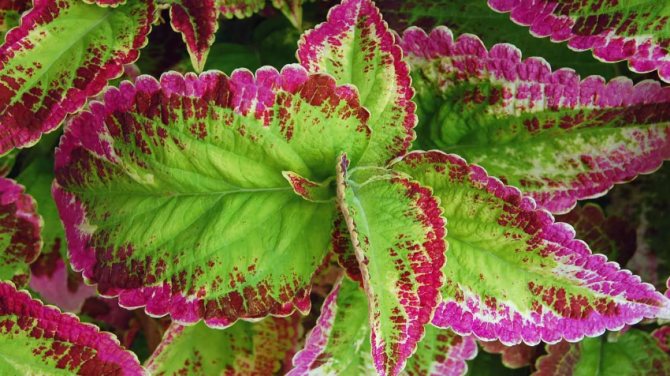

Important! Esoteric specialists are sure that such a gift to loved ones will normalize family relations and remove financial problems.
How can it be dangerous?
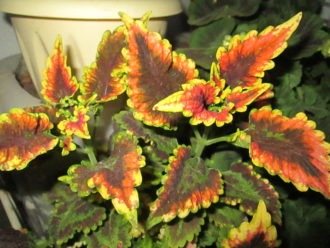

Coleus cannot cause harmful effects on the human body, from the biological and chemical side. The plant does not emit dangerous and toxic substances.
It is dangerous only for a certain category - people who are suspicious and believe in different omens. Indeed, it is better for them not to acquire fiery nettles. This plant is capable of having a detrimental effect on their subtle psyche: constantly observing the growth of a flower, a person will notice changes in development, and associate this with events taking place in his life. A dried leaf will cause panic about the state of health or expectation of trouble. Constant fears will affect the person's aura and really attract sickness and misfortune.
It is not recommended to grow Coleus and unmarried ladies. It can cause a psychological barrier in relationships with men, which will lead to long loneliness.
The tradition of African residents: to plant Coleus on the graves of deceased relatives has provoked the emergence of another name - "cemetery flower". This fact was reflected in superstitions. According to one of them, coleus has a negative impact on the health of a newborn baby, taking away his life energy. Therefore, it is better for parents to refrain from purchasing Coleus after replenishment in the family. If the flower got along well with the owners before the birth of the child, you should not throw it away after this event.
Positive beliefs
Croton is able to modify vibrations. It replaces harmful low ones with high healthy ones, thereby bringing positive energy into your home.
There is a belief that Coleus absorbs negativity in the house and can take on damage or the harmful effects of envy. Therefore, do not be surprised that the flower may wither after guests have visited your home.
Omens by the season
If Croton bloomed in the summer - this is a profit, then soon expect a raise or raise. In general, contrary to the superstitious name Croton poor man, the plant attracts financial well-being and stability. It can often be seen on tables in offices and banking institutions. The leaves of the plant emit a special aroma into the atmosphere, somewhat similar to mint. This smell has been proven to stimulate brain activity and promote productive work.
If your plant decides to please you by releasing its buds in the fall, you are very lucky - this is a good sign. The sign speaks of good luck smiling at you, you can safely start new business and be sure that they will be crowned with success.
An omen for girls
Signs for women and unmarried girls are associated with the flowering of the plant:
- if a lonely girl bloomed Coleus in March, then this year she will meet her lover;
- the plant releases buds for the second time in a row - this is a sign of an imminent marriage;
- for a married woman, a suddenly blooming Croton can mean an early pregnancy, and by the shade of the inflorescences you can determine the sex of the child: bright pink and yellow - there will be a girl, purple and red - a boy
Flower care
Experienced growers say in a voice: Coleus is a rather unpretentious plant, despite its Asian tropical origin. What is the minimum required for this plant?
Watering frequency. Coleus loves high humidity, so you can water it every other day with water at room temperature. Daily spraying is also helpful.
Priming. Since the plant grows very quickly, the soil should be light and nutritious at the same time. A mixture of compost, sand and peat is suitable.
The negative properties of the flower
Along with the unique positive characteristics of "nettles" among the people, there are a large number of unflattering opinions about it:
- Do not keep it at home - it will take away the last strength.
- Forgot to water, did not put it out in the sun - meet trouble on the doorstep.
- Do not start nettles, the last money will go away.


Croton actively responds to negative changes in the energy background. If he began to fade, hurt, analyze what is happening. Maybe there is some disagreement in the family? Does not tolerate the flower of neglect, poor care. To appease the "nettle", systematically water, feed it, surround it with attention and care. And you will be rewarded a hundredfold.

